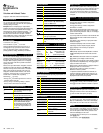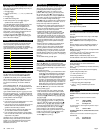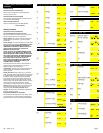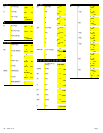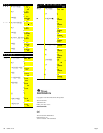
US 15àRGà1L1àA Page 2
Stored Operations › œ
Op1 and Op2 each can store an operation with a constant
value, which you can repeat by pressing only one key, as
many times as desired.
1. Press › or œ.
2. Enter the operator first (+, -, Q, P, IntP, or ^) and then the
number.
3. Press › or œ.
4. Initialize with a starting value.
5. Each subsequent time you press › or œ, the
operation with the constant is applied.
The computation with the stored operation appears on the
first line of the display, and the result appears on the
second line. If you don’t want the computation line to
display, press ‡$"® to hide it. Or, if the
expression does not fit on the line, it will not show. When
space permits, a counter on the second line shows how
many times you have pressed › or œ.
To clear the contents of Op1 or Op2, press ‡$$,
select Op1 or Op2, and press ®. Then press ‡ to
return to the last result display.
Rounding Š ‘ ’ “ ˜ ™ š
You can round results with Š in conjunction with place
value keys to specify a given number of places. (The
internally stored value is not rounded.) The calculated
value is padded with zeros as needed. You must press Š
again each time you change the number of places.
Keys Action
Š
Rounds in thousands.
Š‘
Rounds in hundreds.
Š’
Rounds in tens.
Š“
Rounds in ones.
Š˜
Rounds to nearest tenth.
Š™
Rounds to nearest hundredth.
Šš
Rounds to nearest thousandth.
Šr
Removes fixed-decimal setting.
These place-value keys also work with Π(see below).
Problem Solving ‹
The ‹ function lets you practice and test your skills in
arithmetic. You can choose either Auto or Man mode.
In ‹ Auto mode (default), the TI-15 presents problems
with one element missing (for example, 5+2=? or 5+?=7 or
5?2=7). You can select the type of problem and choose
from three levels of difficulty. The default is addition at
level 1.
Level of Difficulty. While in ‹, press ‡$ to access
the menu list and press " or ! to select the desired level
of difficulty (1, 2, or 3). Then press ®‡, and the TI-
15 will present problems at the selected level.
Type of Problem. While in ‹, press ‡$$ to access
the menu list, and press " or ! to select the desired type
of problem (addition, subtraction, multiplication, division, or
find the operator). Then press ®‡, and the TI-15 will
present problems of the selected type.
1. You enter an answer.
2. If your answer is correct, the display shows “Yes,” clears
the screen, and presents another problem.
3. If your answer is not correct, the display shows “No” and
indicates whether the correct solution is less than or
greater than the answer that you entered.
4. The incorrect answer is cleared from the display, and
you enter another answer to that same problem.
5. If you enter three incorrect answers to a given problem,
the TI-15 shows the correct answer, clears that problem,
and presents a new problem.
Scoreboard. The TI-15 shows a Scoreboard after every
fifth problem. Every correct solution you have entered
registers a “Yes” in the Scoreboard, and three incorrect
answers in a row register one “No.” After 100, the
Scoreboard returns to zero.
Problem Solving (continued)
When you first enter ‹ and when you press ‡, the
display shows the Scoreboard for a moment before
presenting problems or before showing the menu.
In ‹ Man (manual) mode, you compose your own
problems. While in ‹, press ‡ to access the menu
list, and press " to select Man. Then press ®‡,
and the TI-15 is ready for you to enter your problem and
your solution. It accepts only non-negative integers in this
mode. You indicate a missing element with .
In ‹ Man mode, it is possible to enter a problem that has
one solution, multiple solutions, or no solution. The TI-15
tells you how many solutions the problem has.
¦ Problems with one missing element generally have only
one solution. You get three tries. After three incorrect
answers, the calculator displays the correct answer and
then clears so you can enter a new problem.
¦ Problems with two missing elements have multiple
solutions. For example, ?+?=5 has 6 solutions; ?x?=24
has 8 solutions. (In this type of problem, the question
marks replace the operands; they may not appear in the
place of the operator or the answer.) These problems are
not cleared after a correct solution or after three incorrect
answers; the problem remains so you can enter other
solution sets, until you clear the problem manually by
pressing ”.
¦ When the answer to a problem is not a positive integer
(such as 9P2), the TI-15 indicates that it has zero
solutions. But if you enter answers, it will tell whether
they are greater than or less than the correct answer.
Inequalities. Instead of entering an equation, you can test
an inequality using . You get only one try, because the
inequality statement is either true or false. With inequalities
you can enter decimals. Press once for <, and press
twice for >.
To exit Problem Solving, press ‹ again.
Place ValueŒ ‘ ’ “ ˜ ™ š
While in ‹, Man mode, you can determine the place
value of a digit; determine how many ones, tens, hundreds,
thousands, tenths, hundredths and thousandths a number
contains; or determine which digit of a given number is in a
specified place.
¦ Determine Place Value:
L After entering a number, you can determine the whole
number place or the decimal place of a given digit by
pressing Πand then pressing the digit in question.
L If you have a number with a repeated digit, when you
press this digit the TI-15 analyzes its right-most
occurrence. To find the place value of those to the left,
press the given digit again before the answer appears.
Each time you press the given digit in succession, the
display shifts to the next occurrence of this digit to the
left and shows the place value for this occurrence.
While in ‹, Man mode, you can access a Place Value
menu by pressing ‡$.
¦ Find out how many ones, tens, hundreds, thousands,
tenths, hundredths, or thousandths a number contains
(default): If necessary, press ‡"®$, select the
11- setting, and press ®‡. Enter the number to be
analyzed, press Œ, and then press “, ’, ‘, ,
˜, ™, or š.
¦ Find out what digit of a number is in a specified place:
Press ‡"®$, select the -1- setting, and press
®‡. Enter the number to be analyzed, press Œ,
and then press “, ’, ‘, , ˜, ™, or š.
The answer appears briefly and then clears so you can
press another digit or place value key. Once the Œ
function is active, it is not necessary to press this key
before each digit or place you wish to examine for a given
number. You need to press
” before entering a new
number to analyze and then activate Πagain.
To exit the Πfeature, press
”.
Error Conditions
Arith Error
Arithmetical error.
Syn Error
Syntax error.
P0 Error
Attempting to divide by zero.
Mem Error
Error in attempting to store entry in memory.
Op Error
Error following steps for using Op1 or Op2.
Overflow
Error
Overflow.
Underflow
Error
Underflow.
In some cases, ” restores the last display before the
error message appeared.
Errors appear in history as Error.
Battery Replacement
Place protective cover over the TI-15 and lay the calculator
face down.
Remove screws from back of case, using a small Phillips
screwdriver.
Carefully separate front from back, starting from the
bottom.
Caution: Be careful not to damage any internal
parts.
Remove old battery, using a small Phillips screwdriver, if
necessary. Replace with new battery. Replace back of
case.
Caution: Avoid contact with other TI-15 components while
changing the battery.
If necessary, press
− and ” at the same time to reset
the TI-15 (clears memory and all settings).
Caution: Dispose of old batteries properly. Do not
incinerate batteries or leave where a child can find them.
In Case of Difficulty
Review instructions to be certain calculations were
performed correctly.
Press
− and ” simultaneously. This clears all memory
and settings.
Check the battery to ensure that it is fresh and properly
installed. Change the battery when:
¦
− does not turn the unit on, or
¦ The screen goes blank, or
¦ You get unexpected results.
To continue using the TI-15 until you can change the
battery:
1. Expose the solar panel to brighter light.
2. Press
− and ” simultaneously to reset the
calculator.
TI Product Service and Warranty Information
Product Support
Customers in the U.S., Canada, Puerto Rico, and the Virgin
Islands
For general questions, contact Texas Instruments Customer
Support:
phone: 1.800.TI.CARES
(1.800.842.2737)
e-mail: ti-cares@ti.com
For technical questions, call the Programming Assistance Group of
Customer Support:
phone: 1.972.917.8324
Customers outside the U.S., Canada, Puerto Rico, and the
Virgin Islands
Contact TI by e-mail or visit the TI calculator home page on the
World Wide Web.
e-mail: ti-cares@ti.com
Internet: www.ti.com/calc



